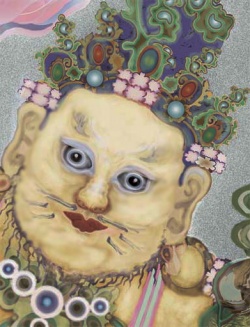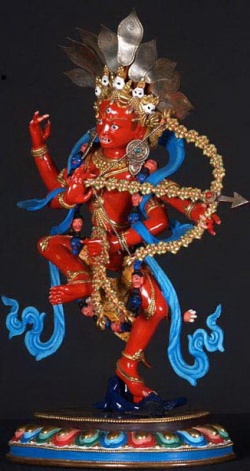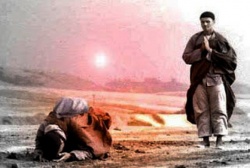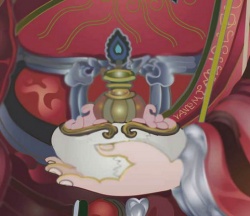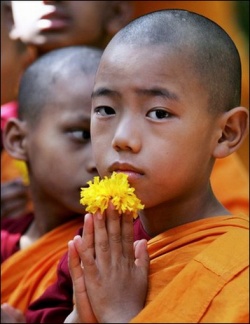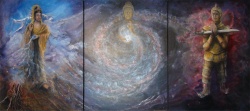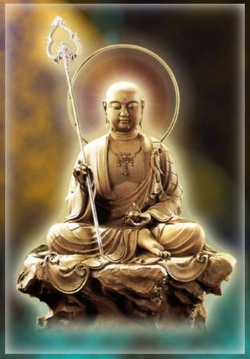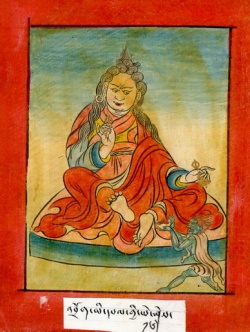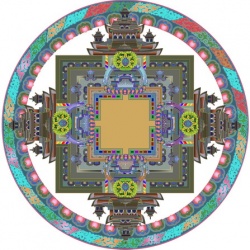The spiritual heritage of ma gcig lab sgron
by Massimo Facchini
In 10551 Ma gcig lab sgron was born in Tibet. She was one of the very few women who had a primary role in the country's religious history; this woman gave birth to a teaching called Bdud kyi gcod yul (Cutting off Spiritual Death) which permeated the four great schools of Tibetan Buddhism. The gcod tradition is still alive in some Tibetan monasteries,2 and in recent years it has started to spread among the western Buddhists in the U.S.A. and in Europe.
The traditional Tibetan sources usually say that Ma gcig received the gcod teaching from the Indian master Pha dam pa sangs rgyas, 3 and in the Grub mtha' (p. 107) the author says that the Gcod yul is a branch (yan lag) of the Zhi byed. While the meeting between Ma gcig and Dam pa (or one of his disciples) is credible, I have doubts about the strict interdependence between the Zhi byed and the gcod traditions. These doubts are based first of all on the difference existing between the two teachings which only have their relationship (that for the Zhi byed is really close) with the Prajnaparamita in common.4
Moreover there are two characteristics in the figure of Magcig that, according to the tradition, make it impossible for her to be the source of a teaching that was so important in Tibetan religious history. Ma gcig is a Tibetan and, moreover, a woman; all the Buddhist teachings come from India, and, according to the traditional sources, everything (writing, medicine, astrology, etc.) was imported into Tibet from India and China. Ma gcig is a woman, and you can't find another woman in the religious history of Tibet who founded a religious tradition. From a sociological point of view, Ma gcig is a diversity in a context of equals.
The two characteristics that give her this uncomfortable position are inverted in a biography of her,5 in which her previous life as an Indian prince is recounted. In her previous life her name was Smon lam grub (pp. 2-3)), the child of an Indian king. During his short life Smon lam grub obtained the ordinary and extraordinary siddhis, converted 100,000 non-Buddhists (p. 6), and worked for the benefit of all sentient beings. When Smon lam grub was twenty years old a dark-blue q,iikinf 6 said to him (pp. 9-10): "I shall kill you and your consciousness will enter me." So saying, she raised her knife to kill Smon lam grub and his consciousness entered her; in this way he was guided to Tibet.
In the land called Lab phyi E'i gang ba (p. 10), in the town called Mtsho me, she saw a man and woman in union and entered the womb of the woman. The name of Ma gcig's mother was 'Bum lcam (p. II), and she came from the family called Phyug tshang. Her father's name was Chos kyi dzal ba, and he was a local mayor. As soon as the baby was born, standing in a rainbow light, she assumed the dancing position of Vajra YoginI(p. 19), and on her tongue there was a red hrf, while on her forehead was an eye.
Her father recognized in her all the signs of a dakini. When she was eight years old, the lama who taught her the Dharma told her parents that she was a dakini and that he had given her the name Shes rab sgron me (Fiery Torch of Prajfia). The girl became very famous in her country and the king ordered Ma gcig's family to bring her to him. When the king asked her name she said: "Call me Rin chen sgron me, Sgron tse, or A sgron" (p. 26). Hearing these words the king said: "If you join the name Sgron me to the place of your birth, Lab, it will be auspicious." So after that she was called Lab sgron.7
Following these biographical notes, let us now consider the spiritual heritage of Ma gcig lab sgron. The Tibetan verb gcod pa means "to cut," and it is very common in Tibetan. It has assumed many derived meanings such as "to cure (a disease)," "to suppress (a passion)," "to kill," etc. 8 The CCK (p. 415) says: "This doctrine is called Gcod yul because it thoroughly cuts (gcod) all the ropes of the mind's (sems) pride and goes beyond the four limits9 and the eight bounds. "10
Again in the CCK (p. 415) it is explained that to define the system of Ma gcig the verb gcod pa can be substituted by its homophone spyod pa (to practice). The Grub mtha' (p. 114) says that the Gcod yul is so called because its precepts "... cut the egoistical mind's activity through the bodhisattva's compassion. The roots of transmigration are cut by means of the explanation of sunyata (stong nyid). Moreover it is also called spyod because one must practice the way of the union between thabs (skillful means, Skt. upaya) and shes rab (profound wisdom, Skt. prajna ), which is the way of the bodhisattvas." The CCK (p. 414) lists the four devils (bdud, Skt. mara) which are the object of the gcod practice. These four are defined as the four "internal devils (nang gyi bdud)":
Thogs bcas (bdud) (Devil) of the senses, concrete.
Thogs med (bdud) (Devil) of the mind, not concrete.
Dga' brod (bdud) (Devil) of lust, desire.
Snyems byed (bdud) (Devil) of pride.
These four are joined together with the four "external devils (phyi bdud)" in the same work (CCK, p. 414):
Phung po (bdud) (Devil) of the body.
Nyon mongs (bdud) (Devil) of passions.
Lha bu (bdud) (Devil) of lust.
Chi bdag (bdud) (Devil) of death.
In the Mahayana system these four correspond to the four mara:11 Skandhamara, the devil who generates the five psychophysical constituents. Klesa-mara, the devil who generates suffering and illness. Devaputra-mara, the devil who generates lust. M~tyu-mara, the devil who leads one to death.
Thus, the objects of the "cutting through" (gcod) are the fourmara (Tib. bdud) who lead one to spiritual death (the root of the Sanskrit word mara is mr, "to die"). The field in which the mara operate is the discursive mind (sems), the intellectual process that is the cause of dualism, assuming a thinking subject different from the object that is thought. The discursive mind is the cause of suffering, of fear; it is the world of our ego, which is anxious about living and dying.
In fact it will be this individual world that will conclude its own existential process; that part of us that we identify with our thoughts and with our rational world. The enlightened mind (byang chub kyi sems), which is innate but latent in all the sentient beings and that has to be "recognized" by the practitioner in order to achieve liberation, is not involved in living and dying; it lives in a relationship of continuous transformation with the whole, being indissolubly joined to it.
The gcod practice is therefore addressed to the destruction of the discursive process and leads to the understanding that"... all things which appear, even the Gods, are a creation and a phantom of our unconquered thought. "12 It is this vision of the world that shows the links of the gcod system with the Prajniaparamita which emphasize the non-dual nature of reality. Gcod'yul is therefore a complete and direct meditative practice because the understanding of reality's emptiness leads to the sudden release from samsara. But how does the gcod practice lead to the goal? The way is through sacrifice and offering; the offering of one's own body and life, and the destruction of the five components of the human being.
From the seed-syllable at the center of his body the practitioner visualizes a dakini (Tib. mkha' 'gro ma), usually Vajra YoginI (Tib. Rdo rje rnaI 'byor rna) or Ma gcig lab sgron, at the top of his head and identifies his consciousness with her. Then he starts dancing with the damaru in one hand, while blowing the rkang gling. I3 The sound of these instruments and the concentration involved give life to many demonic beings in front of the practitioner, who offers them his own body as food. At the end of the rite everything is reabsorbed into the seed-syllable from which everything started. 14
To perform a gcod rite, " ... a cemetery, or any wild site whose physical aspect awakens feelings of terror, is considered to be an appropriate spot. .. "15 To endorse this point, in the Grub mtha' (pp. 115-16) the author quotes three passages based upon the Hevajra Tantra (Tib. Brtag gnyis).16 He states that, for meditation, suburbs and lonely places, the night and the Ma mo house,I7 and cemeteries and woods are considered good. Further on in the Hevajra Tantra it is stated that, having given the gift of your body, the practice becomes still purer. It is also stated that were a lha min (asura) to walk before you, even if it came in the form of Indra, you would not be afraid because of your lion's form.
I think it is important to note that the means to overcome the mind's conditioning is the mind itself, its own projections. This meditative process possesses a great psychological significance. There are two distinct elements in its actualization: a preparatory element, in which the deceptive assumption of the existence of gods and demons is made, and a second element which brings about the certitude that gods and demons are nothing other than emanations of our thought. I9
Two paths are open to man. One leads to a state of submission to joy and pain. Its contents or duration may vary and it is still always the path of samsara. The other path is the way of enlightenment. In order to traverse it, gcod must cut off the root of the cycle of samsara. This process begins with two erroneous views: one general, abstention from evil and so on; one particular, the performance of good actions; transcending both there will be the certainty that there is neither subject nor object. 20
As I said above, one of the derived meanings of the verb gcod pa is "to cure, to heal;" in Tibet many illnesses are considered to be caused by devils and the gcod practitioners are called to give remedy. In cases of pestilence or leprosy they are the only ones who dare to have contact with the infected corpses, because they never become contaminated. This is the reason why people in the West often refer to the gcod practice as exorcism. There is a big difference between the two: exorcism, in fact, assumes the existence of an alien entity which must be "cast out" from somewhere or someone. In the gcod context, however, the devil that the practitioner finds in front of him is his own dualistic mind with its own passions and projections because, " ... from the material world up to omniscience everything will be recognized as the devil's action."21
NOTES
1. On this point the following works agree: B.A. II, p. 981; Tucci, p. 39; Ferrari, p. 121, n. 198; and Vostrikov, p. 134, n. 391.
2. Rgyu ne and Skyabs che in eastern Tibet. M. FACCHINI 25
3. On his life and teachings (Zhi byed) see B.A. II, pp. 867-981. See also CCK, p. 421; Grub mtha', p. 107; Aziz 1978; and Aziz 1979. On the meeting between Dam pa and Ma gcig see Lalou, pp. 39-47. CCK (p. 490) gives a brief account of their meeting and says that Ma gcig (whose nun's name, Tshul khrims rgyan, is given) stayed with him for seven years. The Grub mtha' (p. 114) says that Ma gcig received the gcod teaching from Skyo ston Bsod nams bla rna, who received it from Dam pa, and it does not mention the meeting between Ma gcig and the Indian master. According to this text, the tradition that began with Skyo ston and Ma gcig is called mo gcod, which is different from the pho gcod that was transmitted by Dam pa to Sma ra ser po. On the pho gcod see Lauf, pp. 85-95, and De Rossi. The meeting between Dam pa and Sma ra ser po is recounted in CCK, pp 433-35.
4. On the relationship between Zhi byed and the Prajniaparamita see TPS, p. 92; and Grub mtha, pp. 107 and 113.
5. Phung po gzan sgyur gyi rnam bshad gcod kyi don gsal byed bzhugs so. The complete translation of this work is published in a work titled Women of Wisdom by T. Allione: Routledge and Kegan Paul, London, 1984.
6. Dakini (Tib. mkha' 'gro ma), a goddess or realized yoginr.
7. The biography of Ma gcig is in B.A. II, p. 983; and CCK, pp. 451-60. See also Lalou, p. 49.
8. Das, p. 390.
9. The "four limits" are birth and death, immortality and annihilation, existence and non-existence, and phenomenon and voidness. See Das, p. 968.
10. Sems kyi snyems thag thams cad yul de nyid kyi steng du thad kar gcod de mu bzhi'am mtha' brgyad spros bral dugnas pa na bdud kyi gcod yul dugrags pa yin lao
11. Wayman, p. 116.
12. T.P.S., p. 92.
13. The damaru is an hourglass-shaped pellet drum with two faces which has a very complicated symbolism. The rkang gling is a sort of trumpet made of a human thighbone. On these instruments and their symbolism, see Ringjin Dorje and Ter Ellingson.
14. For a more detailed description of the gcod rite, see E.W., pp. 277-334.
15. David-Neel, pp. 148-66.
16. Snellgrove, pt. I, ch. VI, (6), (19), (25), and pt. II, pp. 19 and 21.
17. Here Snellgrove (pt. I, ch. VI [6]) translates: "Meditation is good if performed at night beneath a lonely tree or in a cemetery, or in the mother's house, or in some unfrequented spot." But the Ma mo are a class of female
demons assuming various manifestations. According to me, the right translation is, "the house of the Ma mo." On the Ma mo see Neumaier as well as Nebesky-Wojkowitz, pp. 269-73.
18. Probably Simhamukha (Tib. Seng ge'i gdon pa can), the Lion-faced dakini .
19. Tucci, p. 88.
20. Ibid., p. 89.
21. CCK, p. 414.
BIBLIOGRAPHY AND ABBREVIATIONS
Western Studies:
Aziz 1978: B. N. Aziz, Tibetan Frontier Families. New Delhi, 1978.
Aziz 1979: B. N. Aziz, "The Work of Pa dam pa sangs rgyas as revealed in Ding
ri Folklore," in Tibetan Studies in Honour of Hugh Richardson, pp.
21-30. Warminster, 1980.
B.A.: G. N. Roerich, trans. The Blue Annals, 2 vols. New Delhi, 1976.
Das: C. Das, Tibetan-English Dictionary. Kyoto, 1979.
David-Neel: A. David-Neel, Magic and Mystery in Tibet. Baltimore, 1971.
De Rossi: E. De Rossi Filibeck, "The Transmission Lineage of the gCod
According to the Second Dalai Lama," in Contributions on Tibetan and
Buddhist Religion and Philosophy," Proceeding of the 1981 Csoma de Koros Symposium, Vol. II, Wien, 1983.
E. W.: W. Y. Evans-Wentz, Tibetan Yoga and Secret Doctrines. London, 1958.
Ferrari: A. Ferrari and L. Petech, mK'yen brtse's Guide to the Holy Places of
Central Tibet. Rome, 1958.
Lalou: M. Lalou, Les Religions du Tibet. Paris, 1957.
Lauf: D. I. Lauf, "Die gcod Tradition des Pha dam pa sangs rgyas in Tibet," in
Ethnologische Zeitschrift no. 1 (1970), pp. 85-95. Zurich.
Nebesky-Woj kowitz: R. de Nebesky-Woj kowitz, Oracles and Demons of Tibet.
Mouton, 1956.
Neumaier: V. E. Neumaier, Matarah und Ma-mo, Studien zur Mythologie des
Lamaismus. Munich, 1966.
Ringjin Dorje and Ter Ellingson: Ringjin Dorje and Ter Ellingson, trans.
" 'Explanations of the Secret gCod J;)amaru' An Exploration of Musical
Instrument Symbolism," in Asian Music, vol. X-2 (1979), pp. 63-91.
Snellgrove: D. L. Snellgrove, trans. The Hevajra Tantra, 2 vols. Oxford, 1959.
T.P.S.: G. Tucci, Tibetan Painted Scrolls, 2 vols. Rome, 1949.
Tucci: G. Tucci, The Religions of Tibet. London, 1980.
Vostrikov: A. Vostrikov, Tibetan Historical Literature. Calcutta, 1970.
Wayman: A. Wayman, "Studies in Yama and Mara," in Indo-Iranian Journal
(1959), pp. 112-31.
Tibetan Texts:
CCK: Dharma Senge (Chos kyi seng ge), Gcod kyi chos 'khor. Three Texts on
the History and Practice of the Zhi byed and Gcod Precepts. New Delhi,
1974.
Grub mtha': Thu'u bkwan Blo bzang chos kyi nyi rna, Grub mtha' thams cad
kyi dang dod tshul ston pa. Varanasi, 1973.
Phung po: 'Jam mgon kong sprul Blo gros mtha' yas, compiler, Phung po
gzan sgyur gyi rnam bshad gcod kyi don gsal byed bzhugs so. New Delhi,
1978.
